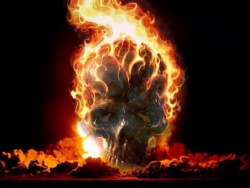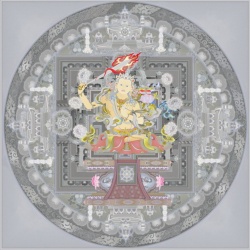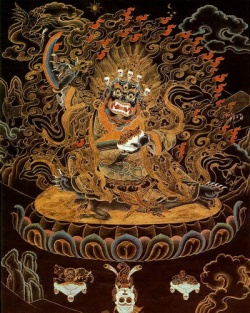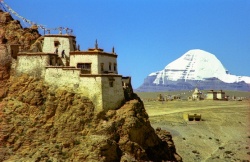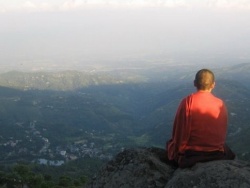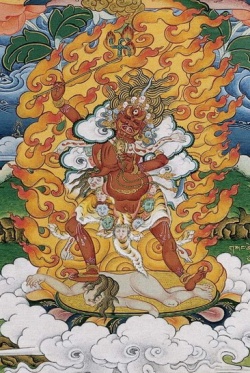Shambhala in the Kalachakra Tantra
By Nick Trautz
We often hear about the connection between Shambhala and the Kalachakra tradition. While the Kalachakra initiation has been given publically by teachers like His Holiness the Dalai Lama and His Holiness Penor Rinpoche, it is less common to have exposure to the Kalachakra Tantra source-material in translation. This year, I have enjoyed the good fortune of studying the Kalachakra texts as part of my graduate program in Buddhist Studies. I thought it might be interesting to share some of what I have learned about Shambhala in the Kalachakra tradition.
The History of the Kalachakra
The Kalachakra is an encyclopedic collection of vajrayana Buddhist knowledge, including material on astrology, the human body, ritual, and meditation practice. The Kalachakra tradition gained prominence in India sometime in the early 11th century, making it the last of the tantric traditions to develop in India. The Kalachakra eventually disappeared along with Buddhism in India, but flourished in the Tibetan world, where it is still studied and practiced today.
The Kalachakra system draws on broad influences in formulating its content, enough so that the text at times must defend itself from critics who don’t recognize some of its material as Buddhist. But in general, the Kalachakra has proven its significance as a major source of vajrayana knowledge, and is present across Tibetan Buddhist lineages. The Kalachakra texts that form the basis of the Kalachakra tradition consist of the Abridged Kalachakra Tantra (the Sri Kalachakra), and its commentary, Stainless Light (Vimalaprabha in Sanskrit). The original and supposedly older root tantra is quoted in these texts, but no version of it has ever been found.
These texts tell the story of the Kalachakra Tantra’s origins at the time of the Buddha. In the final year of the Buddha’s life, a king from a northern kingdom traveled to Dhanyakataka in southeastern India to study the Dharma. The Sanskrit name of that king was Sucandara, Dawa Sangpo in Tibetan. His kingdom was called Shambhala.
The text specifies that Shambhala was a kingdom “north of the River Sita.” While no consensus exits among scholars regarding the historical reality of Shambhala, several scholars believe that Shambhala was an historical kingdom of a different name (circa 850-1250), located in present day Xinjiang province of northwestern China and in eastern Kyrgyzstan, and that the River Sita refers to the Tarim River. The Tarim River basin has been the home to several well-known Buddhist and Bon kingdoms, and there is climatological evidence that this area was once far less arid than it is now; the ruins of stupas are found throughout this vast region, now mostly buried under desert sands.
In India, the king of Shambhala, Dawa Sangpo, was searching for dharma teachings that would not require him to take monastic vows. In response to this request, the Buddha appeared to Dawa Sangpo and bestowed the Kalachakra teachings: outer, inner and secret teachings that depict a sacred world consisting of wisdom and compassion.
Dawa Sangpo returned to Shambhala and taught the Kalachakra for three years before passing the lineage to his son. Six succeeding kings held the Kalachakra teachings and taught them for one hundred years each. We refer to these as the Seven Dharmarajas of Shambhala. The Kalachakra tradition regards each of these kings as emanations of specific bodhisattvas, beginning with Dawa Sangpo as Vajrapani.
The Rigdens
The eighth in Dawa Sangpo’s line, Yasas, an emanation of Manjushri, also received the Kalachakra lineage and taught the tantra for one hundred years. As his reign was drawing to a close, King Yasas foresaw that the Shambhala Kingdom would become vulnerable to barbarian invasion due to the continued adherence of his subjects to divisive caste identities and to sacrificial ritual practices. Yasas gathered the Brahmanic lords from throughout the kingdom and requested them to take initiation in the Kalachakra, and to put aside caste identity to come together as one “Vajra Caste.” The lords eventually agreed, dissolving caste and clan distinctions and abandoning Vedic rituals.
Having achieved the unification of all Shambhala under one vajra clan, Yasas became known as the first Kalki King (Rigden in Tibetan). In Tibetan, rig (usually transliterated as rigs) means “family,” “caste” or “kind,” while den (from dang ldan pa) means “endowed with” or “holding.” So Rigden literally means “endowed with family” or “holder of the lineage,” a name representing the bringing together of all castes, clans and religious systems of Shambhala into one.
Rigden Yasas was the first of the twenty-five Rigden Kings that the text predicts will reign in Shambhala. Tibetan commentators have calculated that the twenty-fifth Rigden, Raudra, will begin his reign in the year 2327 CE. The Kalachakra predicts that the twenty-fifth Rigden will go into battle against barbarian forces, re-establishing the dharma throughout the world in his victory.
Interpretations of Shambhala’s Significance
The Kalachakra texts themselves do not specify what happened to the Shambhala kingdom. Tibetan commentators take up several interpretations. Some suggest that the entire kingdom of Shambhala became enlightened through the practice of the Kalachakra tantra and has become a pure realm in which beings can take rebirth. Another view specifies that Shambhala is a pure realm on this earth, visible only to those with perception purified in meditation. The text does specify that Shambhala is “behind Mount Kailash.” This has been taken by some Tibetan commentators to mean “north of Kailash,” while some Tibetans believe Shambhala is actually “inside” Mount Kailash. The Dalai Lama once joked that since Shambhala lies due north of India, perhaps it refers to North America, reached by traveling north over the top of the globe!
Tibetan traditions also comment on the identity of the Rigdens. Many Tibetans believe the Dalai Lama to be an emanation of the Rigden king. The Shambhala terma tradition sees the Sakyongs as directly connected to the Rigden, and that the Rigden signifies the inherent strength and brilliance of the mind, the principle at the basis of enlightened society. Ju Mipham, the previous incarnation of Sakyong Mipham Rinpoche, was said to comment at the time of his death that he would seek rebirth in Shambhala. As the Kalachakra texts are of Indian origin, they do not mention the lha or drala deities; the connection of these to Shambhala and the Rigden principle came out of the visionary experiences and texts produced by the Dorje Dradul.
Outer and Inner Interpretations
At first glance, the Kalachakra’s account of the history of Shambhala is striking in several ways. In the Kalachakra, cultural and religious diversity is portrayed as a threat to the integrity of the Kingdom: Rigden Yasas predicts that the different clans, cultures and ritual practices throughout the kingdom would weaken Shambhala, leaving it susceptible to barbarianism. He demands that this diversity be abandoned for unification under one clan and one practice system.
Also striking is the great war against the barbarians predicted for the 25th century. The twenty-fifth Rigden, an emanation of the wrathful bodhisattva, Yamantanka, is prophesied to lead soldiers into battle to annihilate barbarian culture. This might strike us as difficult imagery to understand from a Buddhist perspective. As contemporary Shambhalians, we are taught to value diversity and to abide by an ethics of peace. One response to this interpretive discrepancy is to recall that these texts were written at an anxious moment in the history of Buddhism. Northwestern India in the eleventh century was beginning to face pressure from Islamic military forces; the texts also clearly reflect anxiety about Buddhism’s relationship with Hindu social and ritual life.
But the Kalachakra literature supplies an inner interpretation of these events and specifies the inner interpretation as the definitive one. Chapter Two of the Sri Kalachakra comments that the great battle against barbarianism is really the inner battle against samsara. The text clarifies that the barbarian armies represent our own passion, aggression and ignorance. The four armies of Shambhala represent the antidote to these inner poisons, the Four Immeasurables–love, compassion, joy, and equanimity–while the defeat of the great barbarian general is the defeat of fear itself. And for the vajrayana practitioner, the text specifies how this process unfolds within the body.
Similarly, the inner interpretation of Rigden sheds light on the subtleties of meditation practice. The text correlates the diverse castes of Shambhala to the many kinds of conceptual thoughts. The one who brings those many families of thoughts together as one, gathering the mind in meditation, is known as Rigden, “holder of the family.” For tantric practitioners, this process is explained as a practice unfolding within the inner yogic body. In this way, we are instructed by the text in how to become the Rigden ourselves, gathering the mind, revealing the inherent strength that brings victory over the barbarianism of habitual patterns.
While our Shambhala tradition is totally sufficient on its own for the practice of meditation and the cultivation of enlightened society, I find it interesting to explore the context from which these ideas emerged. Encountering the Kalachakra has informed my understanding not just of Shambhala’s history, but the inner meanings that are represented in it and that are relevant to us as meditators in this age.
